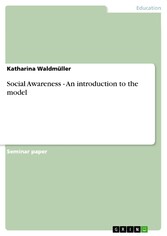Search and Find
Service
Social Awareness - An introduction to the model
Seminar paper from the year 2005 in the subject Didactics - Business economics, Economic Pedagogy, grade: 1,7, LMU Munich (Wirtschaftspädagogik), course: International Work Teams, language: English, abstract: We are living in an age of diversity. The roles of teachers, counselors and team leaders have been expanded to include the consideration of the cultural identities of students, clients and team members. Teachers, counselors and team leaders have a responsibilty to increase their awareness, knowledge, and skills so that students, clients and team members are taught and counseled with approaches that recognize the influence of cultural group membership. If the responsible persons do not recognize the influence of cultural group membership, their subordinates can be expected to profit only minimally from interactions with them. Therefore, developing multicultural awareness is essential for all counselors to accurately interpret the meaning of cultural similarities and differences. Various theories and models have been developed to explain these changing social conditions. Most of the theories are tailored for business management only. A comprehensive theory proposed by Earley and Gibson, though, incorporates a dynamic, multilevel view of teams. It includes perceptions from various research fields and opens new dimensions. This theory will be explained in chapter 2. Chapter 3 will concentrate on one individual element of the theory, namely social awareness. This term will be commented on from several viewpoints. Theories that the authors used to explain social awareness will be introduced. Chapter 4 will contemplate social awareness in the model context. It will reflect on how various kinds of team leaders can utilize the model of Earley and Gibson (2002) according to team disposition (i.e. how the team is arranged, is it a loose or a tight structure). In chapter 5 a critical approach on the model will be adapted. Chapter 6 will make a proposal as to how this model can be applied to promote social awareness. Therefore the simulation game Ecotonos will be introduced and it will be questioned on its suitability for this purpose. Finally, chapter 7 is a short summary of the results and a view of possible future developments.
All prices incl. VAT













